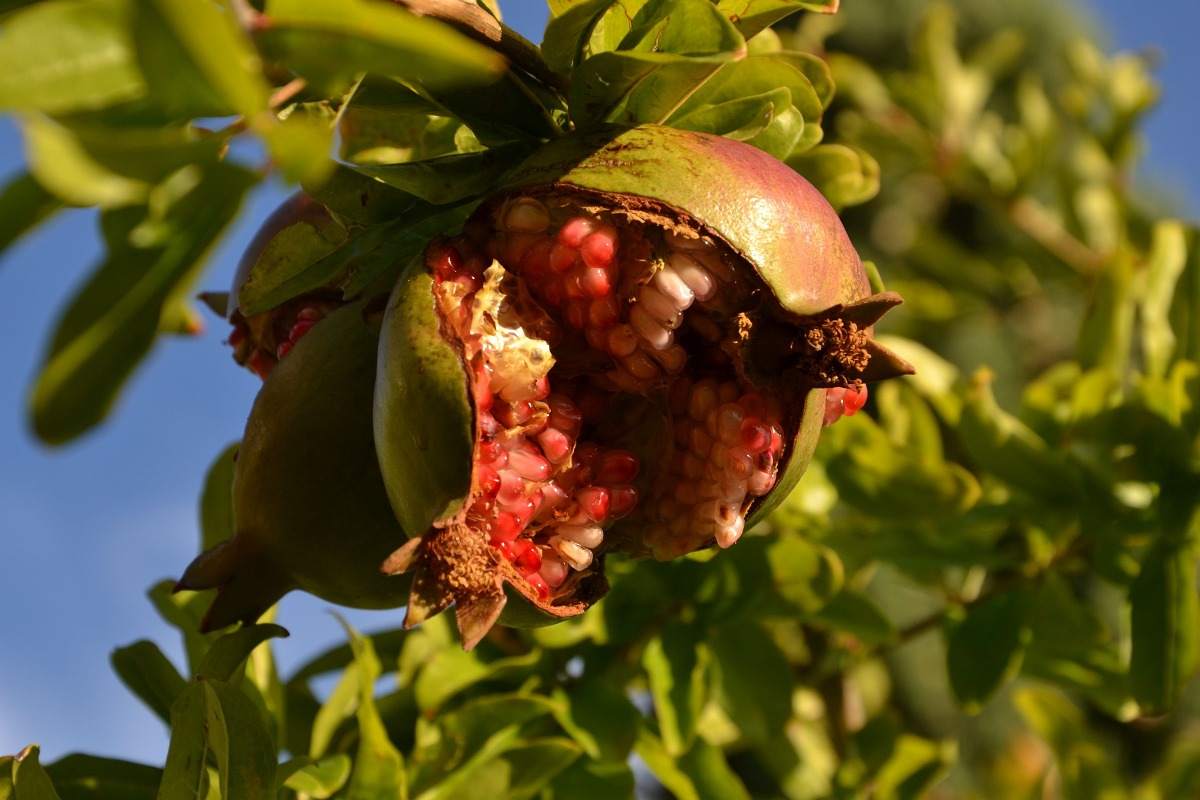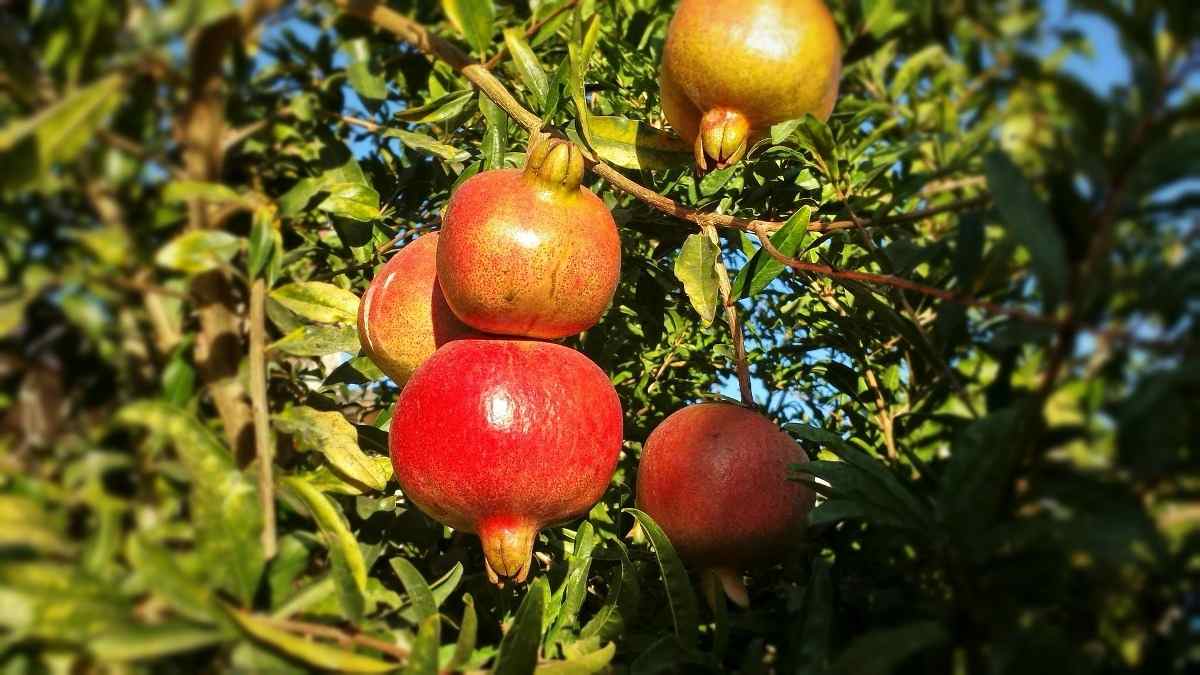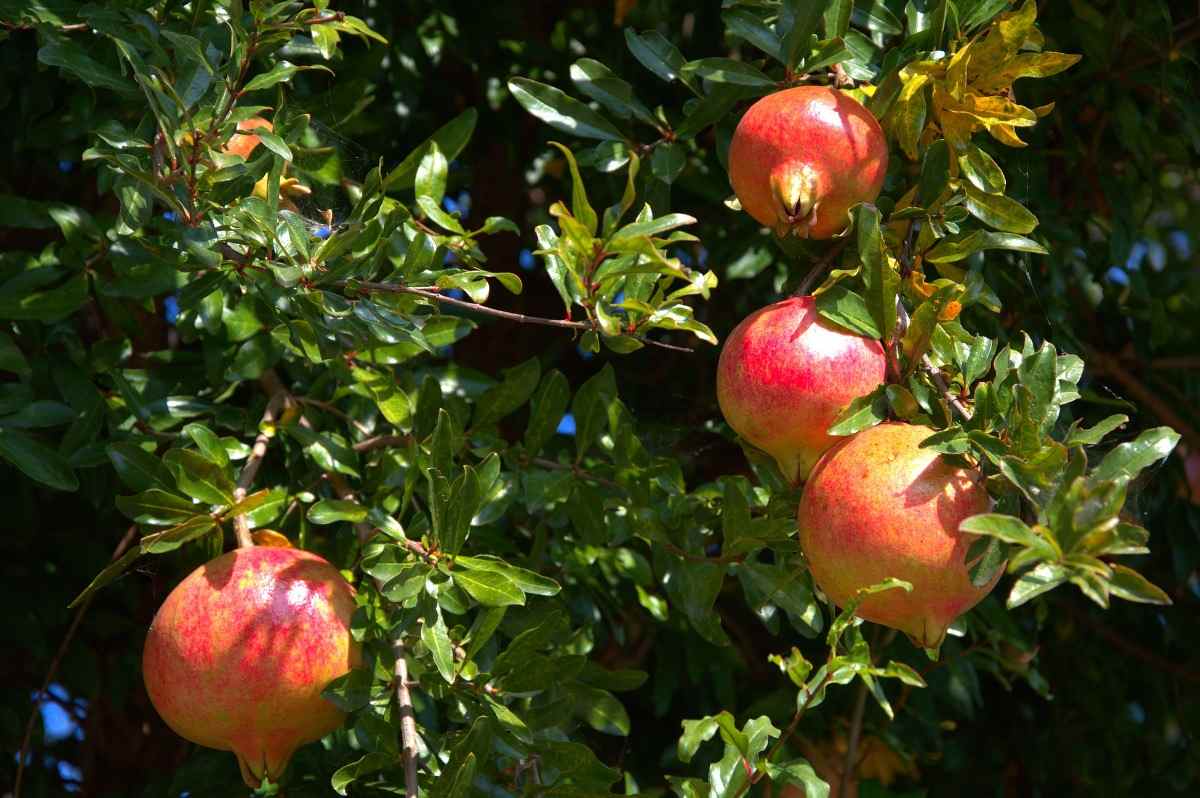Introduction to Pomegranate pests and diseases
The Pomegranate tree is one of the commercially important fruit crops of India and it belongs to the Lythraceae family. The tree is branched and spiny with glossy, leathery, oval to oblong leaves that grow in whorls of five or more on the branches. The Pomegranate tree produces bright red flowers singly at the tips of the branches and a rounded hexagonal fruit with a thick pink-red skin. The Pomegranate fruit has a thick, leathery rind that protects the pulp and seeds inside. The inside of the Pomegranate fruit is separated into compartments by white spongy tissue.
A step by step guide to Pomegranate pests, diseases, and their control
Pomegranate trees grow best in temperate or semi-arid climates with cool winter and warm summer. The Pomegranate trees are less hardy than many other deciduous fruit trees but more hardy than citrus. Pomegranates will suffer severe damage when temperature ranges drop below -10°C. It can be grown successfully on a range of soil types, including calcareous soils and acidic loam but will grow optimally in deep, well-draining loam. Propagation Pomegranate trees are propagated from softwood and hardwood cuttings as seeds will not breed true to type. Hardwood cutting is preferred over softwood due to the ease with which they root. Hardwood cuttings are taken from shoots from the previous season and rooted in nursery beds after treatment with a rooting hormone. And cuttings are grown in the nursery for one season before being planted out in the orchard. Rooted cuttings are best planted in winter or early spring and are usually spaced 3.5 to 5.5 meters apart. The young trees are headed back to a height of 60 to 70 cm after planting to promote branching.

Pomegranates include more than 500 known cultivars and produce medium-sized, leathery fruits containing tangy and juicy berries. The trees are relatively easy to grow and maintain, but they are susceptible to fruit rots, mold, pests, and wood damage. Pollination failure and inadequate sunlight may keep Pomegranate trees from producing fruits. Pomegranate fruits are ready to harvest between 6 and 7 months after flowering. Fully mature Pomegranate fruit turn bright red and makes a metallic sound when tapped. Fruits must be harvested by cutting from the tree.
Major pests and diseases of Pomegranate
The most problematic pests for Pomegranate trees are aphids, citrus flat mite, leaf-footed bug, and omnivorous leaf roller. The major diseases affecting Pomegranate fruit are Alternaria fruit rot, Aspergillus fruit rot, and gray mold.
Pomegranate trees are susceptible to rots caused by pathogens that develop during flowering and fruit growth. Alternaria fruit rot (Alternaria alternate) grows inside the Pomegranate fruits, causing them to become stunted and discolored. Rain and overly saturated soil cause the fungus to grow within the Pomegranate fruit. Though, pathogens live on dead plant and fruit debris during the tree’s dormancy. Aspergillus fruit rot (Aspergillus niger) is similar to Alternaria the fungus grows inside the flowering, growing Pomegranate fruits after rainfall. Fruit skins become pale but not dramatically different. Insects damage diseased Pomegranates; pest control can useful.
Gray mold disease causes harvested Pomegranates to decay at a faster than normal rate. The pathogen develops spores on flower petals, which remain in the blooms until the Pomegranate fruits have ripened. It makes a gray coating of fungal spores that live in the fruit tissue. Pomegranates that are stored in damp and humid conditions exhibit the gray-coated surface as they decay. Blue-green mold can develop on Pomegranate trees but it usually appears when fruits are stored. The symptoms are wet areas on fruit skins and bluish-green powdery mold. Protecting fruits from the gray or blue-green mold is not easy or economical, but removing old fruit and dead branches will help reduce fungal spore production.
Pomegranate fungal diseases are;
As the most concerning diseases in Pomegranate, fungal issues can be the hardest to control. The frequent agitators are Alternaria fruit rot, Aspergillus fruit rot, and Gray mold.
Alternaria fruit rot – Alternaria is also called black rot and causes damage to the Pomegranate fruit in the form of wounds and rot on the interior of the fruit. It mainly occurs after heavy rains just when the fruit is beginning to form.
Aspergillus fruit rot – Aspergillus fruit rot has similar timing and effects as Alternaria fungal issues.
Alternaria fruit rot and Aspergillus fruit rot appear after rains as the flowers begin to open and infect the internal portion of the Pomegranate fruit. Wounds should occur after flower initiation for these two infections to occur. The only exterior signs of disease can be a slight off-color in the peel, and lighter weight due to internal decay. Though, this problem usually is not apparent until fruit sorting after harvest.
Gray mold disease causes problems after harvest. While the Pomegranate tree is flowering, airborne spores are spread to the open flowers and enter the fruit. The disease is activated with free water, normally during the postharvest wash, and spreads when stored at room temperature. Though, if a postharvest fungicide is used, it can get into the crown of the fruit to prevent infection.
You should not miss this: Drip Irrigation for Vegetables.
Treating Pomegranate fruit diseases
Control of fungal issues should start before the Pomegranate fruit develops in early spring and continue through summer as fruits mature. Use a copper fungicide according to the directions and then promote good circulation by pruning in the dormant season to open the canopy. Many of the exact causes of these diseases are not completely understood but fungicide use and proper cultivation of the Pomegranate plants can help the tree combat minor infestations. Good healthy Pomegranate trees are less likely to be bothered by minor fungal issues. In the case of Cercospora, removal of diseased leaves, twigs, and fruits could help control its spread, along with fungicide application.
Pomegranate pests and diseases symptoms and their management
Cercospora fruit spot
Symptoms – Light brown spots on leaves and fruit which enlarge and coalesce to form large black patches on Pomegranate fruit; black elliptical spots appear on twigs and become flattened and depressed with a raised margin; infected twigs dry out and die; infection can cause plant death.
Management – Diseased fruits must be removed and destroyed; infected twigs and branches should be pruned out; applications of suitable fungicides can help to control the disease.
Aphids
Symptoms -Aphids are yellowish-green in color and they suck the cell sap from the lower surface of the leaves and devitalize the plant. Then, they secrete a sweet sticky substance, which attracts fungal growth. The affected plant leaves show chlorotic patches. High humidity favors the multiplication of aphids. Both adults and nymphs suck sap from growing shoots, flowers, and young Pomegranate fruit. Heavy infestation leads to stunting or week tree. Sooty mold and soft rot can develop on the fruit.
Control – Spraying with Dimethoate (0.03%) or Malathion (0.1%) at 15 days interval effectively controls the pest population. Encourage natural enemies and keep the field free from crop debris and weeds. Spraying a strong jet of water to dislodge the aphid. If infestation is severe spray appropriate insecticide.
Leaf-footed plant bugs
Symptoms – Both adult and nymphs feed by penetrating their mouthparts to the thick skin of the fruit to the arils resulting in the withering of stung arils.
Management – If the infestation is severe apply appropriate insecticide.
Mealybug
Symptoms – The insect infects all parts of the Pomegranate plant. Both nymphs and adults suck the sap from the leaves, flowers, and fruits, resulting in yellowing of plant leaves, curling, and shedding of flowers and tender fruits. And, also the market value of such fruits reduced. In dry season insects can invade plant roots and suck sap. Due to honeydew secretion, sooty mold can develop on leaves and fruits.
Management – Spraying soap solution reduces the mealybug disease population. Encourage natural enemies and if the infestation is severe apply suitable insecticide.
Omnivorous leaf roller
Symptoms – Larvae enter the fruit by craving surface grooves, particularly where the two fruits touched. It causes tunneling in fruit. Due to the skin damage, secondary pathogens can infect the fruits and result in rotting.
Management – Keep the field free from weeds and remove the infected fruits and burn them. Use the pheromone trap to kill adult insects.
Pomegranate fruit borer pests
Symptoms – The female butterfly lay eggs on tender leaves and after hatching the larvae feeds on fruit by the boring hole. The damaged fruit rots and then emits a foul smell. One can see the excreta of larvae near the hole. Then, the final stage larvae come out of the hole and pupate by spinning the web.
Management – Remove the damaged Pomegranate fruit and burn them. Grow available resisting varieties and if the infestation is severe spray suitable insecticide.
Citrus Flat mite
Symptoms – Suck sap from Pomegranate fruit surface resulting in skin russeting, checking, or leathery skin. This leads to a reduction in the market value of Pomegranate fruits. The citrus flat mite damage starts from the stem end of the Pomegranate fruit.
Management – Application of sulfur before and after flowering reduces the mite population.
Pomegranate Butterfly
Symptoms – It is prevalent during the ‘mrig’ bahar. The adult female eggs on flower only or young Pomegranate fruits. On hatching, the caterpillar bores into fruit and then feed on the pulp. The fruits rot and drop off.
Control – The affected fruits must be collected and destroyed. From the flowering to fruit development stage regular sprays of Carbaryl (3mg/liter of water) at fortnightly interval is effective in controlling the pest.
Bark-eating Caterpillar Pests of Pomegranate
Symptoms – The caterpillar bores the bark and feeds inside. Several holes can be seen on the trunk and trees lose productivity. Wood dust and faecal matter hanging in the form of the web around the affected part is an indication of the borer activity.
Control – The webs around the affected portion must be cleaned. A cotton swab soaked in petrol or kerosene must be inserted in the holes and sealed with mud. Alternate sprays with Carbaryl (2.5 g/liter of water) or Quinalphos (2 ml/liter of water) or Methomyl (3.5 g /liter of water) is effective in controlling the caterpillar pest.
Whitefly
Symptoms – Adult females lay eggs on the lower surface of apical leaves in circles or small groups. Eggs hatch after a week and the crawlers dig their mouthparts into the leaf tissue for sucking the sap and remain static as “scales” throughout the remaining part of their larval and pupal period.
Serious damage is caused by the excretion of honeydew secreted by the by whitefly, which runs down to the fruit and the upper surface of plant leaves. Under moist conditions, sooty molds can develop on the honeydew, reducing photosynthesis and hindering the respiration of Pomegranate plants. The damage by whitefly also leads to yellowing of plant leaves and stunted growth, in severe cases leading to shedding of leaves
Control – Whiteflies can be trapped by hanging bright yellow sticky traps coated with polybutene adhesive at the height of the canopy. Spraying water with high volume sprayer by focusing the nozzle towards the under the surface of plant leaves helps in washing out the honeydew, eggs, larvae, pupae, and adult whitefly. This must be followed by spraying Triazophos 40 EC (1.5 ml/liter of water) or a mixture of 1.5 ml of Monocrotophos 36SL and 1.0 ml of Dichlorvos 76 EC per liter of water. The sprays are repeated at an interval of 8 to 10 days.
Scale Insect pests of Pomegranate
Symptoms – The scales insects can be identified by the presence of small black swollen spots on the branches and the Pomegranate fruits. Adults and pupa suck the cell sap from the fruit and the tender shoots causing drying of branches. In case of severe infestation, the whole Pomegranate tree dries up. The insects secret honeydew like substance this attracts black sooty mould. As a result, all the plant leaves and the branches turn blackish affecting the growth of the plant.
Control – Removal of alternate hosts, which harbor the scale insects. Spraying the affected patches with Quinalphos (0.06%) at 15 days interval helps to control the pest.
Fruit Fly
Symptoms – The attack is prominent during the rainy season. The female lays eggs under the rind of the fruits by puncturing. After hatching the caterpillars feed on the pulp. The affected Pomegranate fruits cease to develop and drop. The damage leads to severe economic losses.
Control – Since the pest remains inside the Pomegranate fruit chemical control measures are ineffective. And, using ‘fly traps’ containing Methyl Eugenol and an insecticide can control the pest.
Commonly asked questions about Pomegranate farming and it’s pests
In case if you miss this: Moringa Pests, Diseases, and Control Methods.

How much time take for a Pomegranate tree to bear fruit?
When growing a Pomegranate tree, as it takes 5 to 7 months for the fruit to become mature and the tree itself needs 2 to 3 years before it bears more than a couple of fruits.
How many Pomegranates can you plant per acre?
A Pomegranate orchard can have between 150 or 200 trees per acre, with about 18 to 20 feet between rows, and a tree every 12 or 18 feet.
What is the best fertilizer for cultivating the Pomegranate tree?
The Pomegranate tree needs adequate nitrogen for best growth, as nitrogen supports the growth of foliage and production of flowers that eventually set fruit. You can use ammonium sulfate, a high-nitrogen fertilizer, or a balanced 10-10-10 formula, starting in spring after the Pomegranate tree begins to show new growth.
How do you increase the Pomegranate fruit size?
Increasing the size of Pomegranate fruits is more about pruning, watering, and fertilizing than anything else. Larger fruit will be formed on older wood so pruning a Pomegranate to be more like a tree than a shrub will help.
Why is my Pomegranate tree dying?
If your Pomegranate tree is losing leaves, it can be due to natural, non-damaging causes such as deciduous annual leaf drop. Pomegranate leaves turn a pretty yellow color before they drop to the ground in fall and winter. Then, this can cause Pomegranate tree leaf loss, an unhealthy, low fruit-bearing tree, or tree death.
Why does my Pomegranate not flower?
Inadequate light levels are a central reason Pomegranate plants fail to produce flowers. A garden exposure that provides at least 8 to 10 hours of direct sun rays daily, particularly from spring to fall is a necessity.
The Conclusion of Pomegranate pests and diseases

Pomegranate crop is more vulnerable to many pests and diseases, hence it requires extensive care to control these insect pests for quality produce and better yield. You may also check this: How to Make Money from an Organic Compost.
Pomegranate super marketing